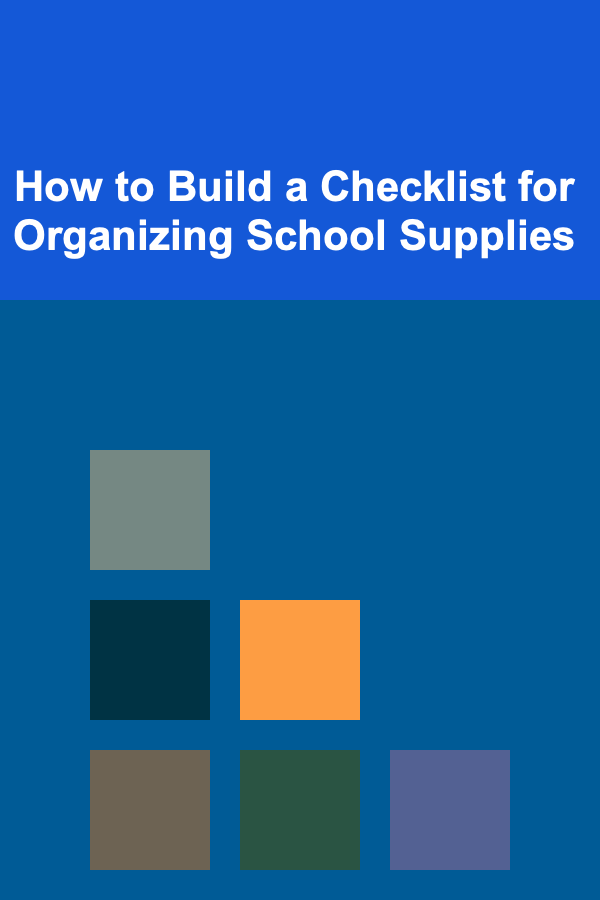
How to Create a Checklist for Onboarding New Employees
ebook include PDF & Audio bundle (Micro Guide)
$12.99$10.99
Limited Time Offer! Order within the next:

Effective onboarding is essential for the smooth integration of new employees into an organization. A well-structured onboarding process can lead to increased employee satisfaction, higher retention rates, and a faster path to productivity. However, without a clear and organized checklist, the process can become disjointed and confusing for both the new hire and the team.
In this guide, we'll discuss how to create a comprehensive checklist for onboarding new employees. This checklist will cover everything from pre-boarding activities to post-onboarding follow-ups, ensuring that no critical steps are missed.
Pre-Boarding Activities
The onboarding process should start before the employee even steps into the office. Pre-boarding activities help set the tone for the new hire's experience and allow them to feel welcomed and prepared on their first day.
a) Send Offer Letter and Employment Contract
- Before the first day, make sure the new employee has signed their offer letter and any necessary employment contracts. This sets clear expectations for both parties.
- Include information about salary, benefits, and job responsibilities.
- Make sure that they understand the company's policies, confidentiality agreements, and any other legal documentation that needs to be signed.
b) Provide Welcome Materials
- Send the new hire a welcome package with company-branded items (like a mug or notebook), an employee handbook, and any other relevant documents.
- Include a brief overview of the company culture, mission, values, and any employee programs or perks that might be useful.
c) Set Up IT and Workspace
- Ensure that the new hire's workspace is ready before their arrival. This includes a desk, chair, and any other necessary office supplies.
- Set up their computer, phone, and email accounts. Grant access to any relevant software, internal systems, and applications they will need.
- Prepare security access cards or keys if applicable, as well as any necessary login credentials.
d) Assign a Mentor or Buddy
- Pair the new employee with a mentor or a "buddy" from their department. This person can serve as a guide, helping the new hire navigate their first few weeks and providing insight into the company culture.
- Ensure that the mentor or buddy understands their role and is ready to support the new employee.
First Day Activities
The first day sets the tone for the entire onboarding process. It's essential to make the new hire feel welcomed, informed, and comfortable. Here are the key elements to include in the checklist for the first day.
a) Welcome Meeting and Introduction to the Team
- Schedule a welcome meeting with HR or the hiring manager to discuss the agenda for the first day and what the employee can expect in the coming weeks.
- Introduce the new employee to their immediate team and other key staff members, including anyone they'll work closely with.
- Provide an office tour, showing them important areas like the break room, restrooms, meeting rooms, and emergency exits.
b) Review Company Policies and Benefits
- Spend time reviewing the company's policies on working hours, dress code, remote work (if applicable), and any other important policies.
- Go over the employee benefits package, explaining health insurance, retirement plans, and other perks available to them.
- Discuss time-off policies, including vacation, sick leave, and public holidays.
c) Provide an Overview of the Role and Expectations
- Review the new hire's job description and set clear expectations for their role. Discuss short-term and long-term goals and how success will be measured.
- Clarify the reporting structure and any immediate tasks they should focus on in the first few weeks.
d) Set Up Access to Necessary Tools and Systems
- Ensure that the new employee has access to all the tools they need to perform their job. This might include specific software programs, collaboration tools, or internal communication systems.
- If any training is required for these tools, schedule time for it during the first week.
Week 1 Activities
During the first week, the focus should be on providing a comprehensive understanding of the company, its processes, and the employee's role.
a) Conduct Department-Specific Training
- Set up training sessions for the new hire to learn about the department they will be working in. This should include a deep dive into their specific duties, expectations, and team dynamics.
- If the employee needs specific certifications or licenses, make arrangements to start those training sessions.
b) Provide Introduction to Ongoing Projects
- Introduce the new hire to current projects that are underway in their department.
- Allow them to observe meetings or briefings, giving them a chance to understand the scope of work and how the team collaborates.
c) Encourage Networking and Relationship-Building
- Organize a team lunch or a virtual meet-and-greet, if remote, to encourage social interactions.
- Encourage the new hire to set up one-on-one meetings with key colleagues in different departments to understand their roles and foster cross-functional collaboration.
d) Provide Regular Check-Ins and Feedback
- Schedule daily or weekly check-ins with the new hire to discuss how they're settling in and address any concerns.
- Provide constructive feedback on their performance, and make sure they have the resources they need to succeed.
Week 2 to Week 4 Activities
In the second to fourth weeks, the new employee should be gradually integrated into their role and given more responsibility. The aim is to ensure they are adjusting well and meeting performance expectations.
a) Deepen Training on Role-Specific Tasks
- Continue providing in-depth training on the tasks and responsibilities associated with their role.
- Ensure they are becoming comfortable with their day-to-day responsibilities and provide support as needed.
b) Encourage Participation in Team Meetings
- Invite the new hire to participate in more team meetings and encourage them to contribute.
- Encourage them to share their insights and ask questions during meetings, which will help them feel involved and valued.
c) Review Performance and Provide Additional Support
- At the end of the first month, schedule a more formal performance review to assess how the new hire is progressing in their role.
- Provide feedback on their strengths and areas for improvement, and offer additional support or training if needed.
Ongoing Support and Development
Onboarding doesn't end after the first month. Ongoing support is critical for continued success and employee satisfaction.
a) Continue Check-Ins and Mentorship
- Even after the first few weeks, keep up regular check-ins with the new hire. This helps ensure they continue to feel supported.
- The mentor or buddy can continue to provide guidance and be a resource for questions.
b) Provide Career Development Opportunities
- Start discussing long-term career goals with the new hire and explore development opportunities within the company.
- Encourage them to take part in any company-sponsored professional development programs or workshops.
c) Evaluate and Refine the Onboarding Process
- Solicit feedback from the new employee about their onboarding experience. This can be done through surveys or informal conversations.
- Use their feedback to continuously improve the onboarding process for future employees.
Conclusion
A well-designed onboarding checklist is a key tool for integrating new employees into your organization effectively. By following the steps outlined in this guide---from pre-boarding activities to ongoing support---you can create an onboarding experience that is not only smooth and organized but also supportive and engaging. An employee who feels welcomed, informed, and prepared is much more likely to be productive, satisfied, and committed to the company for the long term.

How Deep Learning Can Help You Generate Passive Income
Read More
How to Build a Checklist for Organizing School Supplies
Read More
How to Create a Disaster Recovery Plan for Small Businesses
Read More
How to Document Your Yard Sale for Future Reference
Read More
How to Optimize Space in Small Rental Units
Read More
How to Use Acoustic Curtains to Improve Sound Quality in Your Home
Read MoreOther Products

How Deep Learning Can Help You Generate Passive Income
Read More
How to Build a Checklist for Organizing School Supplies
Read More
How to Create a Disaster Recovery Plan for Small Businesses
Read More
How to Document Your Yard Sale for Future Reference
Read More
How to Optimize Space in Small Rental Units
Read More